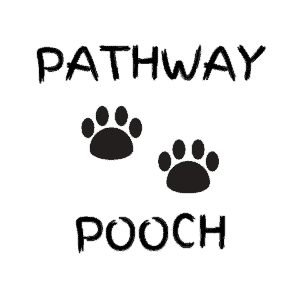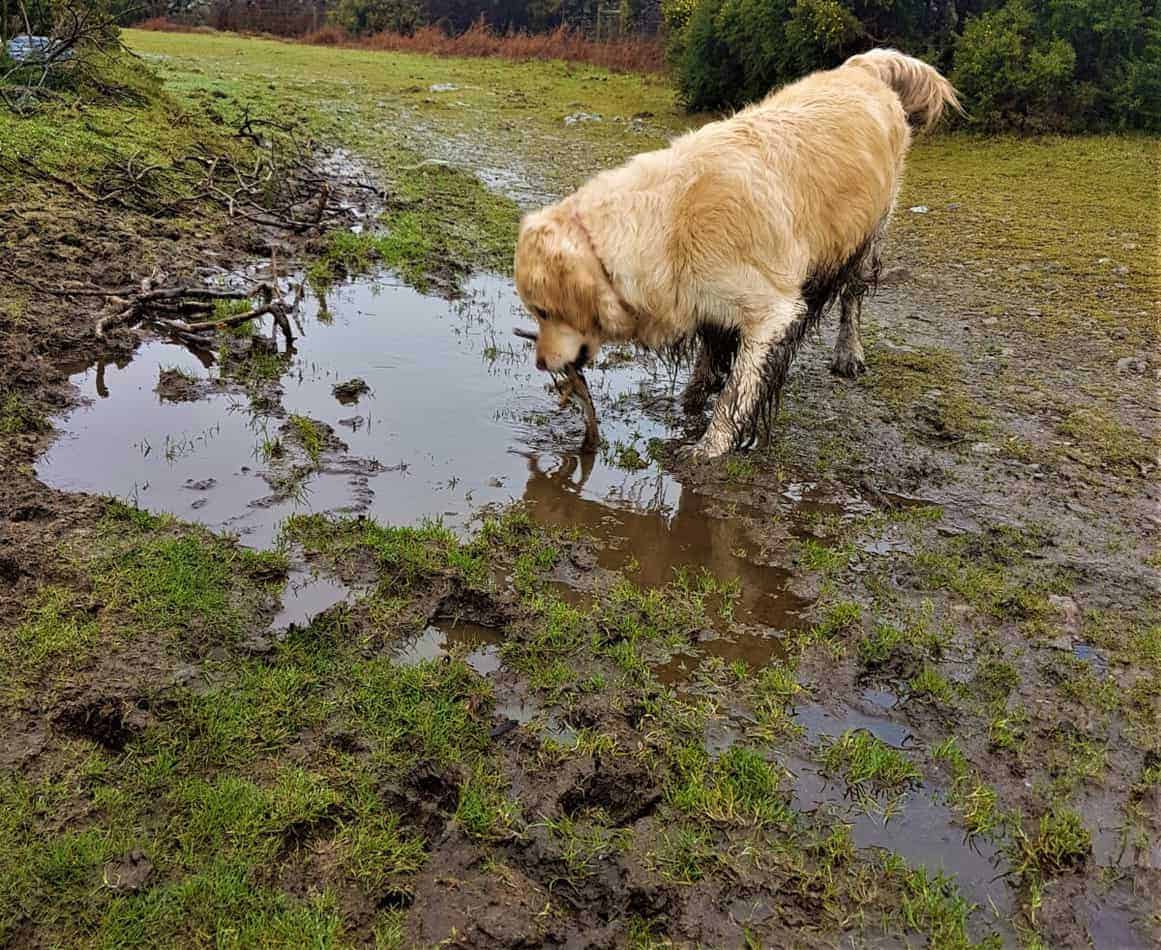If there is one thing the winter brings for dog owners, its mud. It seems no matter what you do taking your dog for a walk in the winter will inevitably end with a muddy dog. The next task is how to manage to keep your house clean with muddy dogs. Being an owner of an extremely muddy dog and having tackled many wet muddy winters I felt it was vital to create a helpful guide for any dog owners that think there is no hope when it comes to muddy dogs.
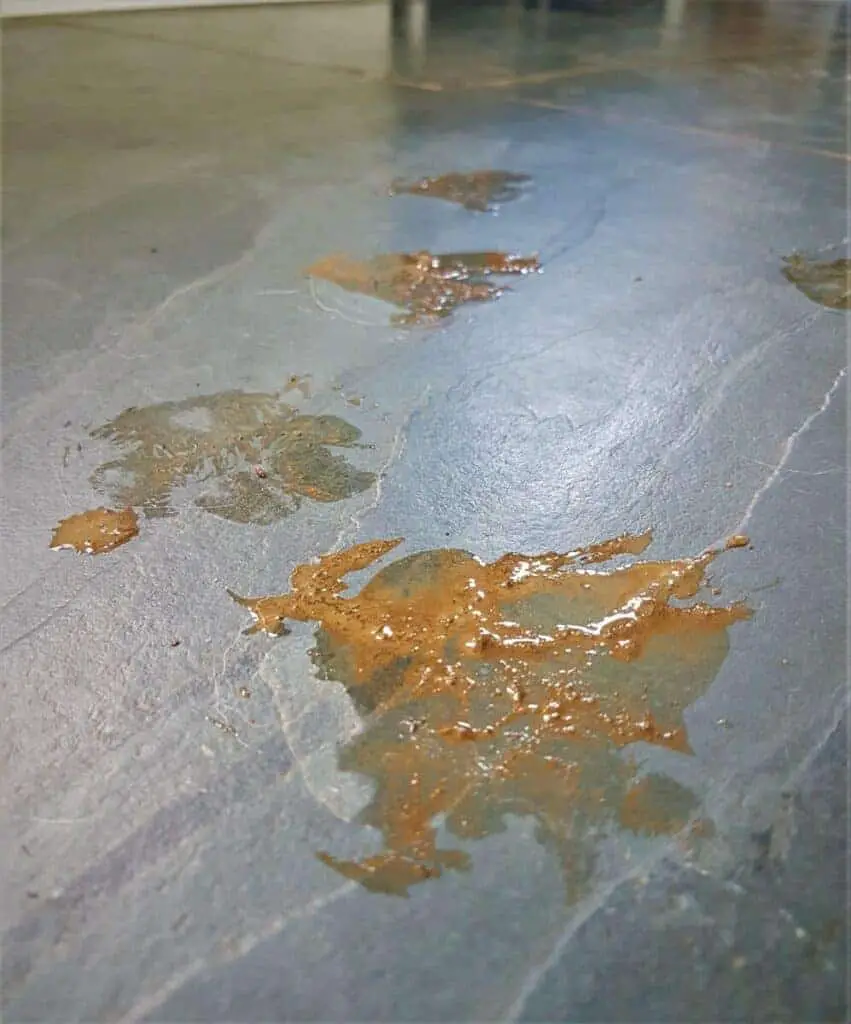
Contents
Preventing Muddy Dog Paws
The main cause of muddy floors are your pooches paws, these mud magnets tend to transfer the most amount of mud onto your hopefully hard flooring. Stopping your dog tracking mud into your house is a task in itself, especially if you are lucky enough to own a garden. Managing your dog’s muddy paws will be the first task in keeping your house clean with muddy dogs. Here are some ways to prevent those unwanted paw prints.
After Walk Cleaning
If you walk your dog in muddy places you will probably be cleaning them after the walk to some degree anyway. However, the benefits of cleaning your dog post-walk will help you on the road to a clean house. Dried mud can be harder to get off your dog and inevitably may make them look cleaner than they actually are, so as soon as their paws get wet mud will be able to transfer more easily onto your floor.
Try using a portable washing system, which can be easily stored in your car for after your walk. These washers tend to range in price from the cheaper but famous “Mud Daddy” to well-known brands like “Karcher”. If you’re not wanting to invest in something like this then you can easily use a large water bottle and a shower attachment, I suggest using the “Kurgo Travel Shower Cap” this will allow you to clean off the majority of loose mud, however, the bottle method won’t have enough power to give your dog a good clean. If you looking for inspiration on cleaning your dog after a walk then check out our article on “How To Clean Your Dog After a Walk”
Doorstep Cleaning
This is something I refer to as doorstep cleaning, which is little effort with there best results. So let’s say you have taken your dog for a muddy walk and given them a good clean before getting back into your car. You then come home and your adorable pooch walks all the way to the door from the car on a wet day they have most likely picked up some dirt from the ground and are about to track it all into your house. Having a couple of items ready on your doorstep for when you get home can make the world of difference.
The items you will need are simple a small tub of water big enough to clean a paw in and a small microfibre towel. These two items enable you to clean your dog’s paws when you get back to your house and dry them off completely to ensure no wet paw prints can be seen either. There is also another benefit to this other than keeping a mud-free house. Dogs can pick up some nasty chemicals and bacteria on their paws especially in the wintertime, which can cause problems in the long run, so good paw hygiene is something you should be aware of anyway. Washing in freshwater can help reduce any harmful substances or bacteria on your dog’s paws. If you want to read more about walking your dog in the winter then check out our article, “A Guide To Walking Your Dog In The Winter”.
Protecting Your Floor From Muddy Paws
Obviously cleaning your pooch is one option you have to keep your house clean with muddy dogs. Another option which you should implement regardless of how often you clean your dog is protecting your floors on both entry and throughout. There are a few different ways of doing this.
Flooring Types
Wood Floors – Hard flooring is always a good option if you have a dog, especially during the puppy stages of their life as little accidents can often give you more stress than needed. Wood is an aesthetically pleasing flooring type, however, there are some things you should be careful of if you have wooden floors. Ensuring your floor is well sealed is a must when you own dogs, especially muddy ones. Unsealed floors can soak up moisture, including spills, urine, and dirty water. When it comes to a muddy dog, often the mud will transfer due to your dog’s paws being wet as well as muddy.
When choosing a wooden floor sealer, it’s a good idea to choose one which is hard-wearing as dog claws can create scratches that look like damage. Wood floor stainers can provide a sealing effect so check the tin to make sure it fully seals the wood. It’s important to clean and sand the floor to help the sealer to soak into the wood, creating a strong barrier against moisture.
Slate Floors – Having had a slate floor for many years now I can honestly say that it is such a great choice for dog owners. The slate is both tough and aesthetically pleasing, with the ability to easily clean when needed. In the summer months when the weather is hot, my dog comes inside to lie down on the slate as it’s nice and cold. Muddy paws tend to clean off easily, however, the grout between the tiles requires cleaning once in a while. It’s important to note that slate flooring also requires sealing, for the best protection and to make it last a long time.
Have a look online for a suitable sealer for slate flooring as there are many options. this will entirely depend on the look you’re going for. I went for a matt finish as it appeared more rustic than a satin or gloss finish. Try testing it on a small area first to see if you like it, then at least you haven’t done the whole floor in something you don’t like the look of. Slate is a porous material so sealing may require multiple applications and top-ups in the distant future, remember to read the instructions on the tin to make sure you understand what you have and how to apply it the best way.
Carpets – It may be that you wanted a dog and you already had some lovely carpets installed. The first thing you must realize is that you will have a battle on your hands from day one, as carpets can be the highest maintenance flooring type. I would suggest the best protection for your carpets would be to ban any muddy dogs from these areas unless you are absolutely sure their paws are dry and free from mud.
If you have darker colors like brown then this will help disguise any mud or dirt for a certain amount of time. As time goes on you will have to think about washing your carpets either by hand or with a carpet cleaner, these can be hired or bought if you think its something you will do often. We use a Vax carpet cleaner for the flooring upstairs and this works wonders, you won’t believe how much muddy water you get from a carpet that looks spotless.
Mats and Runners – This is more of an accessory than an actual flooring type, but one which gives a little bit of an edge when it comes to keeping your house clean with muddy dogs. I would recommend having a super-absorbent doormat, ready to catch any mud your dog intends to track into your house. There are so many options when it comes to absorbent doormats, that it seems difficult to pick one. Reading reviews will help narrow down some of those that are good quality, with just the look of them being something to choose from. If you have a heavily used hallway it may be wise to purchase an absorbent runner mat too. This will catch any dirt or moisture as both people and dogs walk through this area. The other reason to get a runner mat, even if it’s not absorbent is to reduce the wear on that part of the flooring. Usually, if a floor wears down it is not such a problem when its evenly worn across the whole floor. However, when one area gets exposed to heavy foot traffic this one area gets a change in color and appearance, making it stand out and appear uncared for.
Fencing Off
Fencing off an area of your garden can be a big help for many reasons. Firstly its much easier to keep an eye on your dog especially if they are young or prone to eating things they shouldn’t. Secondly, this area will be the only part of the garden subjected to dog urine which kills grass. however with it sectioned off you can instantly dilute the area, reducing the impact it has on the grass. Thirdly you can put a larger amount of top coating on this area to help the water drain away.
Providing your dog is ok with something other than grass below his paws you could put a plastic or rubber mesh down on the ground. This will raise your dog’s paws above the muddy surface and reduce the amount that gets on them. The main reason for fencing off is the easy management that can be done with this area. You can more easily manage the route back into the house create areas that wash and dry your dog’s paws by putting towels and mats on the ground. If there is a sheltered area nearby you can even connect this area of the garden with temporary fencing to allow them to dry off after they have been out for the toilet. Towels and mats in this area will also help your dog to dry off and you can then manage when the appropriate time is for your dog to come back inside.
Bonus Tip – DIY Outdoor Mud Cleaner
Understanding your dog’s route from the muddy garden back into your house is key to keeping their paws mud-free. We previously discussed the use of a super absorbent mat, which helps to dry your dog’s paws and take some of the mud off. This is something you will need in combination with this trick, as your dog’s paws will still be wet.
The main part of this trick involves putting something such as a thick mat made of sponge or thick fabric on the route towards your house. If the mat is able to soak up rainwater then it will become saturated and as soon as your dog steps onto it, water will be released taking some of the mus away. You can also use a shallow tray filled with water that your dog needs to walk through to get back inside. Remember that this method is trial and error, to find the best material for taking mud away when saturated, you will also have to clean the mat regularly, although a quick rinse should be sufficient enough. The shallow tray filled with water would probably be easier maintenance and get more mud off your dog’s paws, however, you should also realize that your dog’s paws will be much wetter meaning your super absorbent mat will have to retain more moisture in the long run.
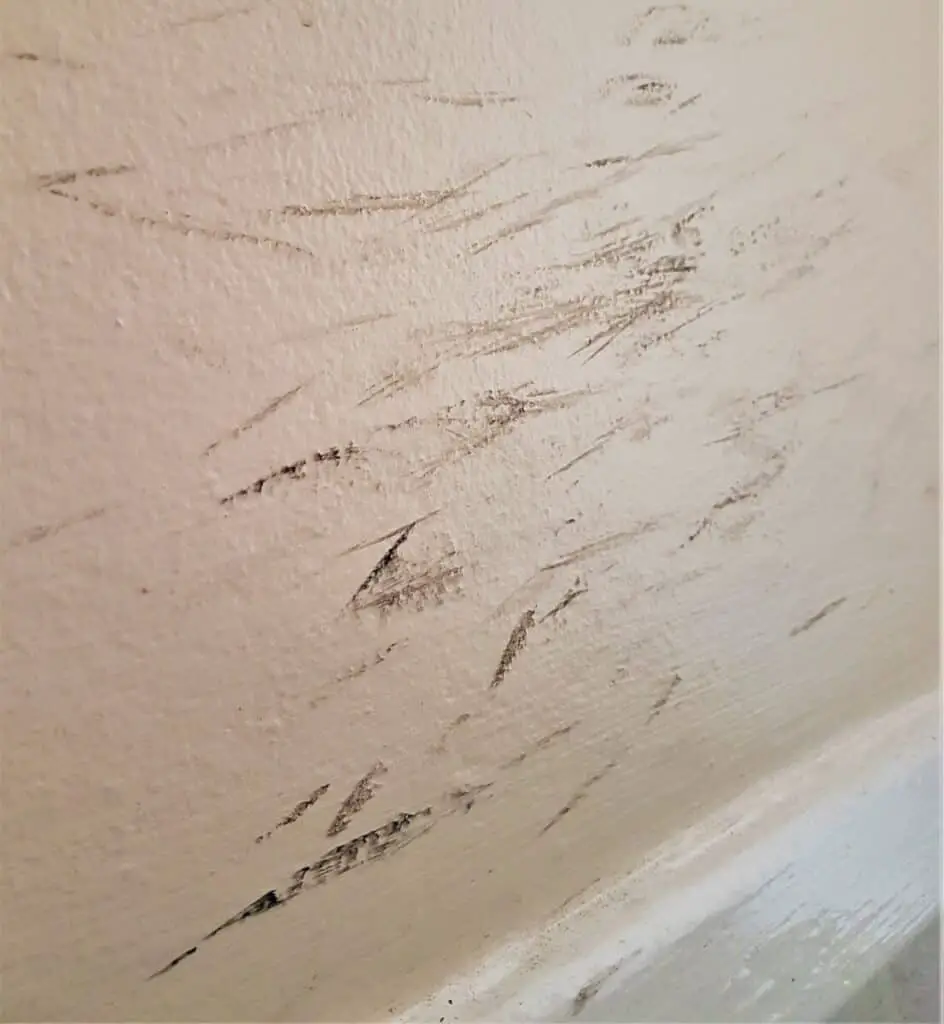
How To Keep Walls Clean With Dogs
Many people who are reading this may not take notice of their dog causing their walls to become dirty, especially if they have children. Unless you live in a house with a rather wide hallway you will inevitably end up with muddy walls at some point or another. Dogs have a unique ability to wag their tails and suddenly brush mud all over your nice clean wall. This is a problem that many owners face especially when you own a particularly fluffy dog. To help with this I have outlined some things that have helped me to deal with this problem.
Wipeable Wall Paint – The paint you use on your walls can have all the difference and as the issue of both muddy dogs and messy children became more apparent, companies started looking at ways to produce wipeable wall paint. This paint is slightly more expensive than your regular paint but allows you peace of mind that you won’t have to keep painting over that section of the wall about a foot and half above the ground. We have used Dulux Easycare in the past but there are always new and improved versions coming on the market. For an up to date list of the best washable paints check out What Paints website for information.
Back Entrance – The worst time to allow your dog to walk through your hallway or into your house for that matter is when you arrive back from your walk. Even if you have taken the time to wash them down before coming home they are going to still be wet with the possibility of mud on them. Using a back entrance to your house can save you lots of hassle and keep the showpiece areas of your house spotless. You can even wash your dog thoroughly round the back with good dog shampoo and dry them off before letting them inside. If you’re lucky enough to have a utility room or an area in which you can keep your pooch before letting them in the house then setting this up as a comfy drying area can prevent any unwanted mud from being tracked into the house.
How To Clean Muddy Walls – Its one thing trying to prevent your walls from becoming muddy and another trying to clean them. If you haven’t got wipeable walls, cleaning them will have to be done with slightly more care. Below is a step by step method on how to clean muddy walls.
- Before wetting the wall brush lightly to release any loose dirt.
- Using a lukewarm solution of water and a dash of washing up liquid lightly wipe the wall where needed.
- After wiping the wall lightly dab with a dry cloth and repeat wiping with the lukewarm solution, this ensures the wall does not get saturated and damage.
- Assess the wall for dirt and if clean dab gently with a dry towel to absorb some of the moisture, leave to dry.
- If the wall is still slightly muddy, leave to dry fully and repeat the process again.
Some dirt will be easy to clean off of a wall and some may be more stubborn. If you have white or cream walls you may struggle to completely clean the area of dirt and may have to consider painting that section again. For issues like this, I always keep the sample pots from when we chose the color of our wall, as this is a good way to touch up areas of the wall without spending any money.
Redesigning – This may seem like an extravagant way of keeping your walls clean but you may want to consider the design of your wall, especially hallways. If your planning on a new design, look into what is called wainscoting or in the UK we just call in paneling…original I know. This is wooden paneling that goes from the ground and raises about 1m from the ground. This paneling will most likely be the part of the wall that gets mud on it and will most likely be easier to wipe down.
Aside from using wainscoting, you can design your hallway or room so that you have furniture in the areas where your dog is most likely to wipe his muddy tail. Try looking into furniture like thin sideboards, shoe racks, or even ornamental ground features.
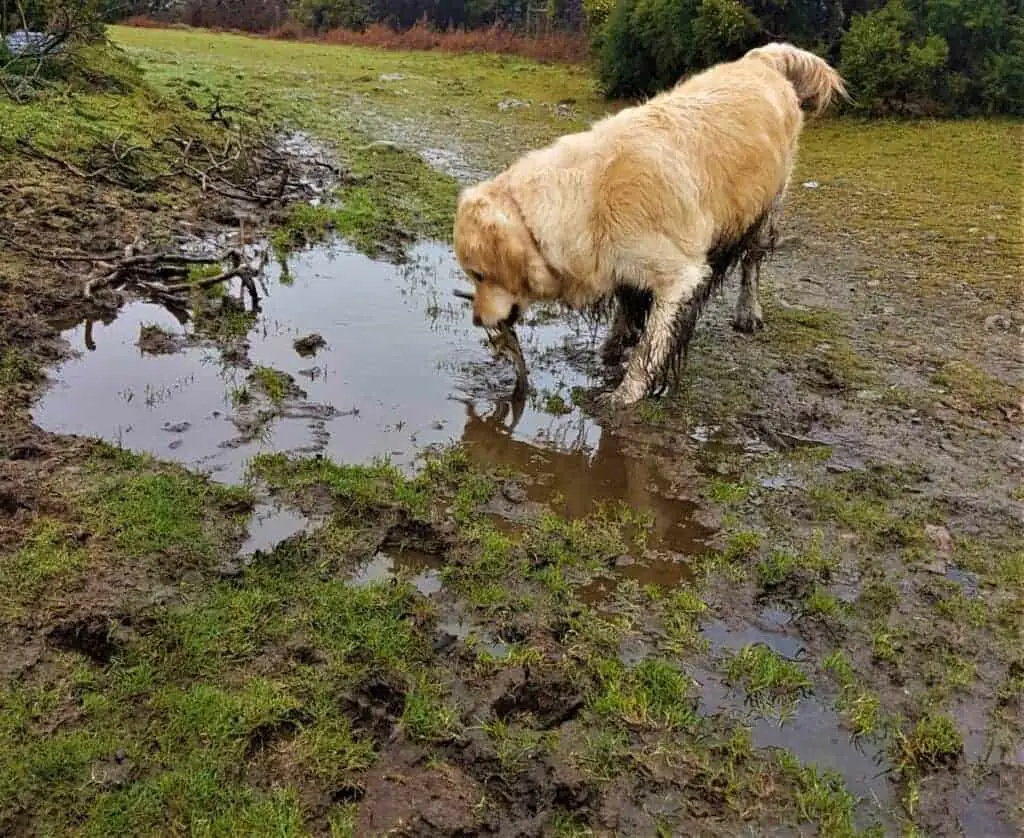
How To Stop a Muddy Garden
One of the most notable issues when it comes to keeping your house mud-free is a muddy garden. It will seem that managing the mud brought in by your dog is not only done after a walk but throughout the day. Dogs will inevitably need to go to the toilet and during a wet day, the ground of your garden will become soft and muddy. The introduction of a dog walking around in constant circles trying to find that perfect spot to pee will only exacerbate the problem causing not only muddy paws at that moment but also during any additional outings to the garden. Here are some solutions for preventing a muddy garden.
Drainage
Drainage is one of the main causes of a muddy lawn and its easy to see why. Sitting water can cause the soil to become a soft muddy mush for many days after it stopped raining, this is on top of your dog going out and churning it like butter. Much of the time flat lawns or those with dips are the most prolific for holding onto excess water, something that is inherently to do with design. Lawns need to be designed with some sloping aspect to them so that water can drain in a particular direction, in most cases towards a drainage pipe.
If you have designed your lawn in such a way that you keep getting standing water on it, don’t panic as there are some additional things you can do to help water drain away quicker.
- Firstly ensuring your downpipes are effectively directed into a drainage system and not onto your garden. If this is not possible you should at least have them extending below the surface of your lawn at least 3 feet, even lower if possible.
- Another problem causing inefficient drainage on your lawn is the type of soil used in your garden. If heavily compacted soft soil is used it can create a barrier over time, not allowing any water to pass through. A method for solving this problem is to create holes in your lawn to allow water to drain effectively. You can then use some lawn sand or easy drain top coating to allow water to drain into these holes deeper into the ground.
- As previously mentioned, the design is one of the best ways to manage excess water and prevent it all sitting on the surface of your lawn. It’s important to design your lawn with a slight incline so that water will drain slowly downhill into nearby drainage systems. The ground will tend to sink in non compacted areas, in particular around buried rubble or other items you didn’t want to take to the dump…..we have all been there.
Lawn Care
Lawn care can come in many forms and most commonly people think about feed for lawns when referring to lawn care. However much of the best care is the removal of unwanted weeds and moss, which often builds up on your garden over time. You can rake a lot of this moss out of your grass, however, you may be shocked by the amount bare patches you didn’t think you had. Removing moss can help with muddy lawns as moss often holds water and does not allow it to drain away, turning the mud below hard and compact.
One of the best methods that I have tried in the past is to aerate the ground using a fork. Creating small holes in your lawn will give it a better chance of draining water away. There are some tools you can use to make the job a little easier and create a bigger effect on drainage. Firstly a motorized aerator is often used to take small plugs out of the ground and store them neatly in a container, these machines are expensive and you can hire them at a smaller cost. Another tool that is often used is a manual roller type aerator, which has spikes that stick into the ground as you roll the device across your garden. Whichever tool you decide to use, keeping your lawn aerated will certainly help keep your dog from churning it up into a mud pit.
Lawn Top Coating
If you are in the middle of the rainy season and there’s no plan to redesign your lawn any time soon, then adding a top coating can help reduce the amount of mud your dog tracks into the house. There are a few different types of top coating you can put onto your lawn to help water to drain away and create a sufficient enough barrier between your dog’s paws and the muddy surface.
Mulch is often used as it biodegrades and acts as a nutrient-rich feed for your grass, be aware that shards of wood can get caught up in your dog’s paws, this is rare though. Other top coatings include lawn sand that can be used for good drainage as mentioned above. This coating can also be used to create that barrier needed to prevent your dog from tracking mud into your house.
Adapting To Your Climate
This method is centered around design, which as I mentioned is often the best solution or most probable cause for muddy gardens. If you have a particularly muddy area of your garden which would require the whole garden to be dug up and redesigned with a new drainage system or downward bias, a simple design can be the best first step solution. Some of the time only a small section of your garden is muddy, due to sitting water, and the small redesign of this area may be all that is required.
Ideas for redesigning small areas of your garden are going to depend on their location and your only personal opinion. Much of the time if you have an area of lawn that is near the extremities then simply building a beautiful flower bed in this space can get rid of standing water completely and give your garden somewhere water can drain away. To really help this process make sure you dig deep into the ground mixing in plenty of mulch to help with drainage. Another idea that could be done is to create a gravel area for sitting, again digging deep into the ground will help with drainage. As this type of area needs no nutrient-rich soil or mulch, you can create better drainage by mixing stones and gravel into the ground and covering with a think layer of decorative stones.
Sometimes it can be goo to just look at your garden and think about how your could design it differently to help prevent mud from accumulating. Your dog will love it too as a more interesting garden can help with their own mental stimulation.
Conclusion
Owning a dog is sometimes not the easiest of tasks and cleaning is something that every dog owner has to deal with. Your home is somewhere both you and your dog relax and so both owner and dog need to have a good balance of freedom and cleanliness. Hopefully, this article has given you some insight and tips on how to keep your house clean with muddy dogs. For more great articles check out our homepage where we talk more about getting out and about with your furry friend.
